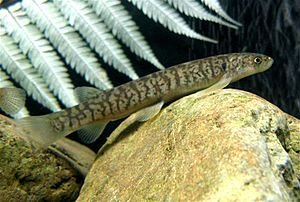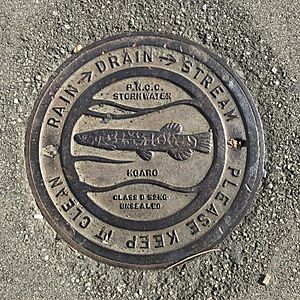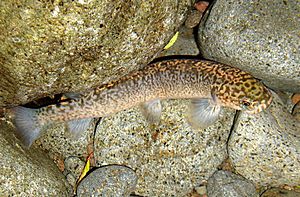Climbing galaxias facts for kids
Quick facts for kids Kōaro or climbing galaxias |
|
|---|---|
 |
|
| Juvenile kōaro | |
| Conservation status | |
| Scientific classification |
The climbing galaxias or kōaro (Galaxias brevipinnis) is a special type of fish. It belongs to the family called Galaxiidae. You can find these fish in Australia, New Zealand, and some islands nearby. In Australia, people call it the climbing galaxias. In New Zealand, it's known as kōaro. It also has other names like short-finned galaxias.
Contents
What Does the Kōaro Look Like?
The kōaro is a long, thin fish, almost like a tube! It's easy to tell apart from other similar fish because of its unique shape. Its sides and back have cool patterns of golden spots and stripes. These patterns shine and glitter in the sunlight, making the kōaro a very pretty fish.
These fish can grow up to about 29 centimeters (about 11 inches) long. But usually, they are around 16 to 18 centimeters (about 6-7 inches) long.
Where Does the Kōaro Live?
Kōaro fish mostly live at the bottom of clear streams. These streams are often shady and have fast-flowing water. Sometimes, you can also find them in lakes, especially in Tasmania. Kōaro can travel far inland in many river systems. This means they are found in more places than other types of whitebait fish.
How Does the Kōaro Live?
A super cool thing about the kōaro is its amazing climbing ability! It can climb up very steep places like waterfalls, wet rocks, and even parts of dams. It uses its wide fins, which face downwards, to help it climb. Even young kōaro can climb out of buckets if they get caught in fishing nets!
While some other galaxias fish can climb, the kōaro is the best at it. It has special fins with strong, backward-facing ridges. These features probably help it grip surfaces and climb so well.
Kōaro fish used to live in large groups in some lakes. For example, in New Zealand's Lake Taupō, huge numbers of kōaro once swam together. The Māori people used special nets to catch them. Sadly, when rainbow trout were brought to Lake Taupō, the kōaro population there almost disappeared. The same thing happened in Lake Tali Karng in Australia when brown trout were introduced.
What Do Kōaro Eat?
Kōaro are carnivores, which means they eat other small creatures. They mostly eat invertebrates. This includes insects that live in water and on land. They also enjoy eating mayfly and caddisfly larvae, which are like baby insects, and small shrimp-like creatures called amphipods.
Kōaro Life Cycle
Scientists believe that kōaro eggs are washed downstream into the sea. The young fish then live in the sea for about six months. After that, they swim back to fresh water. They join large groups of different young fish, which are known as whitebait.
In Tasmania, people used to fish for kōaro whitebait for money. Now, only people fishing for fun can catch them, and there are strict rules about how they can do it. Some kōaro populations live only in inland lakes and don't go to the sea. Their life cycle is similar, but the young fish stay in lakes and calm waters instead of the ocean.
Where Can You Find Kōaro?

Kōaro fish are found along the coasts of southeastern Australia. This includes places like Adelaide and Kangaroo Island in South Australia. They also live in coastal Victoria, including Wilsons Promontory, Tasmania, Flinders and King Islands. You can also find them north along the New South Wales coast near Sydney.
In New Zealand, they live on the main islands and also on the Chatham, Auckland, and Campbell Islands.
Their amazing climbing ability helps them reach the very top parts of streams. These are places where other fish, like trout, can't get to.
- Froese, Rainer, and Daniel Pauly, eds. (2006). "Galaxias brevipinnis" in FishBase. March 2006 version.



